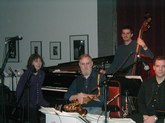|
 |
|
|
 |
 |
About the Author:
 Toshiko Akiyoshi Jazz Orchestra Featuring Lew Tabackin at BirdlandEvery Monday Night
315 West 44th Street, NYC
212.581.3080
www.birdlandjazz.com
Gianni Valenti, Owner
Tarik Osman, Manager By Dr. Roberta E. Zlokower
February 3, 2003 I had the pleasure on a recent Monday night to join a jazz bassist and friend, Hilliard Greene (See Greene Article), for the second set of the Toshiko Akiyoshi Jazz Orchestra at Birdland (See Other Birdland Reviews). Ms. Akiyoshi and husband, Lew Tabackin, on tenor saxophone and flute, were celebrating their 30th Anniversary with their Orchestra and had just presented a concert at Lincoln Center the previous weekend. This is a sixteen-piece Big Band, with the capacity for Big Band Swing, as well as Progressive Jazz and Classical Music motifs. Each individual musical presentation was more and more impressive, as Ms. Akiyoshi, who is a tiny musician, originally from Manchuria and then Japan, blends into her own Orchestra from her piano or conducts from upfront, with her tiny fingers and hands. These much larger, male musicians are totally focused on Ms. Akiyoshi, as she is clearly the leader. However, her husband, Lew Tabackin, is highly instrumental in the planning and organization of the music and orchestral engagements. He is also an extremely talented saxophonist and flautist, with both rich warm sounds and eclectic virtuosity, depending on the theme of the music. Ms. Akiyoshi could be compared to the top pianists of today, with amazing dexterity and passion for her extremely fascinating music. The first piece of this second set featured a Swing rhythm, with steady percussion, strong horns, and solo saxophone. During the solos from the featured horns, Ms. Akiyoshi stood in front of her Orchestra, with her eyes totally focused on the performing musicians, before she leaped back onto her piano bench. She then changed the musical mood to her own version of Vivaldi's The Four Seasons, which have also been re-orchestrated by Astor Piazzolla (See Binelli/Ferman Review and upcoming Review of Avantango). Ms. Akiyoshi's Four Seasons refer to the life in a small village in Japan. Her Winter Movement is called Repose. Her Orchestra suddenly replicated those sounds of traditional Japanese instruments and gave me the musical sensation of blowing wind, which turns into soft, exotic feelings, with brushed symbols and a mellow dance rhythm. One could have danced a slow Foxtrot to this section of Repose. Mr. Tabackin played his saxophone in seamless, flowing fashion. I imagined the proximity of a warm fireplace, protected from the blowing, Japanese winds. Most of this Movement was played without the piano. The Spring Movement, Pollination, mimicked the sounds of bees buzzing from flower to flower. This was an exquisite passage. Mr. Tabackin began Pollination with his versatile flute, as the bees and birds were imagined to be fluttering and frolicking. Suddenly, the Orchestra moved into a Latin Beat, a Bossa Nova. I thought of James Galway (to whom I am listening, as I write this review.) Ms. Akiyoshi conducted in a minimal fashion, as she allows her musicians to realize their needs to improvise a bit, as probably no two performances of any one piece are exactly the same. There was another saxophone solo, and then Mr. Tabackin continued on flute, while the percussionists persisted with the Bossa Nova rhythms. At times, this Big Band sounded like a Progressive Jazz Orchestra and at times like a Latin Jazz Orchestra, and even sometimes like a Classical Music Orchestra with the swirling sounds of the flute, the bees swirling and humming. Summer, called Norito, about praying, begins with a tape of a Japanese man praying and singing, who is then followed by the warm and earthy bass. Then the trombones, then saxophone, and then trumpets express themselves for full dynamism and vitality of this summer ritual. The tenor saxophone could have been a French horn, with its wild and deep resonations. This Movement was a fusion of Classical and Jazz. Suddenly, in the Autumn Movement, Harvest Shuffle, the Full Orchestra switched to a Swing Band rhythm, with Mr. Tabackin returning on his tenor saxophone. There was a trombone solo here, with an exciting and engaging quality. I would like to mention that Ms. Akiyoshi was brilliant and brimming with enthusiasm on her piano. Her compositional talents are remarkable, and I would recommend reading some of her publications (See Bio) and listening to her CD's. I would also mention that Hilliard Greene assisted me with technical information, regarding the use of rubber and metal mufflers on the horns. Toshiko Akiyoshi's Jazz Orchestra ended this set with Chasing After Love, a full Progressive Jazz piece, to which only a bee or a hummingbird might be able to dance. The music swelled to a high pitch, with Lew Tabackin in total control of his amazing saxophone. Ms. Akiyoshi is an amazing sight, standing in front of this large Orchestra, so tiny, with uplifted hands, as she kept her musicians totally focused and blended. I look forward to returning to Birdland on future Monday nights to hear Toshiko Akiyoshi's Jazz Orchestra again. This was a truly classical and memorable, musical experience. Toshiko Akiyoshi Jazz Orchestra at BirdlandPhotos by Dr. Roberta E. Zlokower
February 3, 2003

Toshiko Akiyoshi Jazz Orchestra

Toshiko Akiyoshi on Piano, Husband Lew Tabackin, on Tenor Saxophone

Guest, Hilliard Greene, and Scott Robinson

Toshiko Celebrates 30 Years with Her Orchestra

Lew Tabackin with Members of the Orchestra

Members of the Orchestra

Hilliard Greene Hangs Out with the Musicians

Tarik Osman, Birdland Manager, and Roberta

Tarrik and Hilliard

Tarik and James, Bartender
|
|
|












